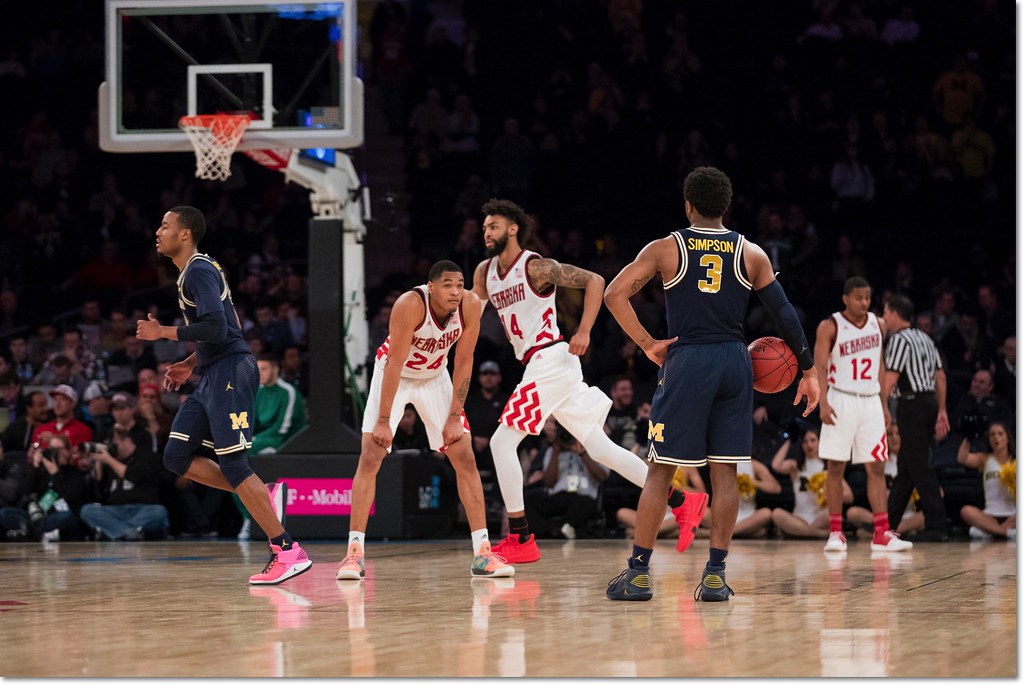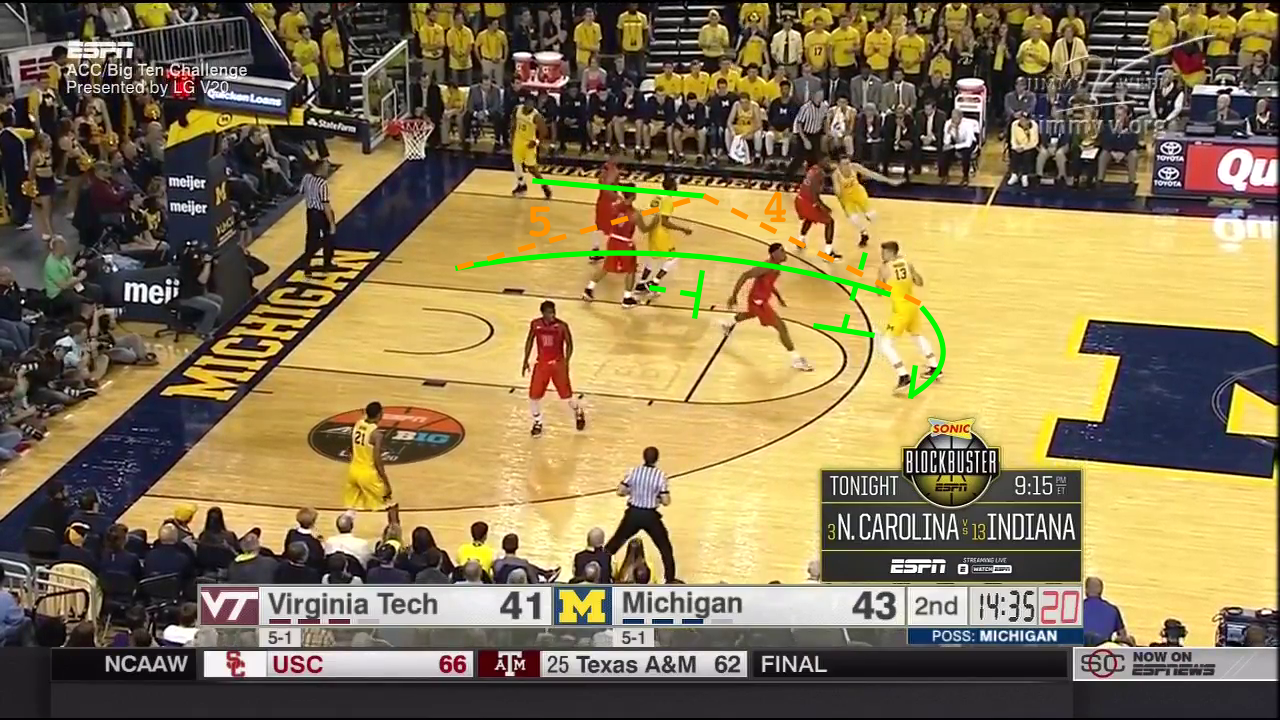Hoops Mailbag: The Beileinbag

 SPONSOR NOTE. HomeSure Lending is once again sponsoring our NCAA Tournament coverage this year, and once again that is going rather well. I'm not saying Michigan's second straight run to the second weekend of the tournament is due to this great partnership of sports blog and home-financing expert; I'm not saying it isn't, either. I certainly don't want to test this theory. If you're looking at buying a house this spring/summer you should talk to him soon.
SPONSOR NOTE. HomeSure Lending is once again sponsoring our NCAA Tournament coverage this year, and once again that is going rather well. I'm not saying Michigan's second straight run to the second weekend of the tournament is due to this great partnership of sports blog and home-financing expert; I'm not saying it isn't, either. I certainly don't want to test this theory. If you're looking at buying a house this spring/summer you should talk to him soon.
ICYMI. The Poolebag. Chartin' threes. The Texas A&M preview. Pre-game matchup analysis/feelingsball roundtable.
I started digging into this first question and, once we wrapped up the roundtable, realized I wanted to dedicate the entire post to it. Before we hit the Sweet Sixteen game, let's take a look at some of the ways John Beilein's offense confounds defenses.
Reads on Reads on Reads

There's a lot happening up there. [Marc-Gregor Campredon]
Hey Ace,
This question is inspired by the “Indiana” Play. In football posts, specific plays are often referenced and then how various counters are deployed to react to a team biting on the base play. Do you have an example of a common play M runs and some examples of counters we run off of it?
Brian
It's important to begin this by differentiating between football and basketball offenses, especially since many Michigan fans are much more familiar with the inner workings of the former. Football offenses are more rigid; every play needs to be a set play (obviously) and the execution of the play happens within a few seconds, so even plays with options/reads are limited to quick on-the-fly reads.
Basketball has a lot more improvisation, even within the more regimented offenses. There are 30 seconds to get a good shot. Part of what makes Beilein's offense so difficult to pick up is that Michigan's "plays" involve constant reads based on how the defense reaction to the initial action. Add in that a player could break the play off entirely if there's a defensive breakdown and it's often tough to pin down what they ran—the same offensive set can produce very different-looking actions and results depending on a cascading series of decisions made through the course of the possession.
For example, here's a nine-minute long video showing the various things Beilein's offense does to set up, run, and play off of one action, a pindown screen on the wide side of the court:
You can watch the whole thing; you can also get the general idea within a few clips. Depending upon how the defense plays the screen, the player running off the ball can pop out for a long jumper, curl off the pick for a midrange shot or drive, or turn down the screen and cut to the basket—and that's just the initial part of a play that has a half-dozen other options to come if the defense manages to account for all of those.
Those aren't different set plays; it's Michigan's players internalizing the offense to the point they can all make those reads as a team. That Beilein develops his players so they can not only execute his offense but do so while being one of the most turnover-averse teams in the country is nothing short of remarkable.
[Hit THE JUMP for some more examples.]
The Unstoppable Set

A lead guard who can read the defense is a must. [Campredon]
My favorite Beilein set that works beautifully for the original question is one I've featured on this site before. Unfortunately, it was during December of last season, so I don't exactly blame you if you didn't see it the first time around. This also means I don't feel bad about copy-and-pasting my own work:
This set requires its own section because Michigan ran it twice in a row, getting two layups as VT reacted to the success of the first play and in doing so opened up another way to get a bucket from the same set. I've diagrammed the first basket in two parts [click to embiggen].
MAAR starts with the ball and gives it off to Walton, then heads below the free-throw line. Walton swings it to Duncan Robinson, who's arcing to the wing. Walton runs to the corner as Robinson passes it to Wagner, who's popped outside the three-point line. This is where it gets fun.
Wagner pivots to face the near side, causing his defender to take a step in that direction. As he does this, Robinson cuts across the court, which accomplishes two things: he effectively sets a screen for Wagner, and as he continues across he clears out enough space that his man can't help on a Wagner drive. Wagner pivots back to face the far side and performs a give-and-go with Walton while MAAR picks off Wagner's man. MAAR's defender is in a tough spot. He doesn't react to the screen and impede Wagner, allowing another open layup.
That is gorgeous.
Beilein dialed up the same set on Michigan's next trip down the floor. This one plays out slightly different and still manages to get a layup. Robinson's cut across the floor is shallower and doesn't impact Wagner's defender as Wagner pivots and gives the ball to Walton. MAAR's defender recognizes the pick this time and helps cut off the potential give-and-go, so MAAR pops out to the top of the key—nobody contests the pass from Walton to MAAR because all the focus is on Wagner's cut.
A better three-point marksman would probably just shoot this; there's enough space to pull without much of a shot contest if MAAR goes right up with it. Even without the shot, this action allows Michigan to reset quickly, and you can see that Beilein has designed this play so there's still ideal spacing to set up the next action from this set, a downhill handoff to Zak Irvin.
MAAR starts to drive left into the heart of the defense, causing a chain reaction. Irvin's defender has to help cut off the drive, but as he's diverting his attention to MAAR, Irvin cuts over the top of MAAR and gets running handoff. The effect is akin to a reverse in football; the defense is all moving one way as Irvin is going the other with a lot of momentum. MAAR's man tries to switch onto Irvin, but with the laws of physics being what they are, he can't prevent Irvin from getting to the rim for a layup—one that's barely contested because Wagner moved to the other side of the paint, taking the rim protector away from the side Michigan wanted to attack.
This is a small part of why Beilein is rightfully regarded as an offensive genius. There are, without a doubt, more wrinkles and counters built into this set; we just happened to see two of them on consecutive plays. If Michigan runs the set correctly, it's remarkably difficult for a defense to shut down all the available options.
It's also a big part of why any "Fire Beilein" talk is still completely, utterly insane. Michigan is only 154th in three-point percentage while attempting the 21st-highest rate of threes in the country. You'd think that would spell doom for a Beilein offense, yet they have the nation's 19th-best adjusted efficiency. They don't have a great shot creator or a dominant post presence. I don't expect Michigan's outside shooting stuggles to continue; once those start falling, M's offense is going to rank among the elite once again.
Oh, weird, how'd that last part stay in? Guess I'll just leave it.
More Evil Sets
I've been secretly building a collection of Beilein's most diabolical sets on the gfycat page—while unfortunately my library there isn't searchable by keyword, a site-wide search for Beilein brings up some gorgeous offense (also some ref reactions).
This play is quick and evil, so I'll take you through one more:
Michigan is getting into their offense. Wagner sets an off-ball screen for Matthews, who's at the top of the key, for a potential lob—it's actually there, as Wagner sets a great screen(!), but MAAR doesn't want to risk the pass. An opportunity for two easy points missed, but there's more.
Wagner immediately heads over like he's going to run a high screen with MAAR, but instead receives a handoff before MAAR heads for to set a pick for Eli Brooks in the corner. Brooks, I'm guessing, has the option to take the screen, but he sees the defense overplaying it and makes a hard baseline cut instead—if the defense doesn't recover he has a layup. Both defenders go with him. MAAR pops to three-point line, gets a short pass from Wagner, and drills an uncontested three.
For those who love to get on Michigan's occasional issues inbounding the ball, here's a killer baseline out-of-bounds set Beilein ran in the same game, using the inbounder (MAAR) as a sneaky off-ball screener to get Wagner a layup.
Bottom line: if you see Wagner pivot at the three-point line, expect something good to happen, and if you really want to learn about basketball this evening, get your eye off the ball and watch how Michigan moves around it.
Similarly, if you want to see why the first two games were so difficult, watch our lack of movement on some posessions. Guys just standing around, not cutting. When we are moving, we cut teams up.
Didn't Painter say that Beilein had basically ditched most of his offense, going with straight Pick-and-Roll? Might've been just for Purdue, but it seems like Beilein's not married to the stuff.
There are times Beilein (and most any team, a lot of them quite often) will simply spread the court, not run any set plays, and let their lead guard pick apart the defense however he chooses—with Michigan, usually a high screen, which has evolved from normally being a pick-and-roll to normally being a pick-and-pop with Wagner at center.
Michigan has a different offense that they'll use against a zone because it requires an entirely different approach. (Think Mitch McGary passing out of the middle of the Syracuse 2-3 while surrounded by shooters and off-ball motion.) Some defensive approaches or matchups call for you to ditch the offense and freestyle a bit. That can look ugly or listless at times—it often comes off as "heroball"—but it doesn't necessarily make the wrong strategy, especially if you've got a guy like Nik Stauskas who's a threat as both an off-the-dribble marksman and finisher at the rim.
"and if you really want to learn about basketball this evening, get your eye off the ball and watch how Michigan moves around it."
Can confirm. It's a really entertaining way to watch the game too.
Similar to the joys of watching D line play the last few years.
they struggle early in the seaon and lose to some teams they shouldn't. It's complex as heck and takes time to learn. But then it clicks and they start destroying nearly everyone in sight. Seriously, that has to be hard as hell for a new kid out of high school to pick up. But once he does, holy crud it is gorgeous to watch..
I think his offense was even more complicated in previous stops, but as the game has changed and he's been able to attract talent that leaves early for the NBA, he's realized he doesn't necessarily have 2-3 years with everyone coming through the program for them to adjust. WVU wasn't a heavy pick-and-roll team. Darius Morris and Trey Burke ran a ton of it not just because they were good at it, but because making that play is simpler (and something they were more accustomed to) than executing Beilein's motion sets. That became the base of a lot of the offense and they could install more pieces as the season went along. Every year he's broken out plays or strategies in the tournament that I don't remember seeing at all during the season; sometimes (like with McGary vs. Cuse) it's the basis for the entire gameplan.
He's really good at this.
It was (and unsurprizingly still is) a big part of the Butler offense
That, along with junking the 1-3-1, was one of the first examples at Michigan of Beilein showing the flexibility that his detractors claimed he didn't have.
The other day in the piece about which Beilein player had the most clutch plays I was fascinated watching the Stauskas plays again for the first time in a while. I know that the players all have different strengths and that teams have no doubt adjusted....but when was the last time you saw a back-door cut or alley-oop in the regular half-court offense? There were so many examples of beautiful open layups/dunks in those clips and we don't see much that anymore it feels like - aside from some Wagner cuts to the hoop.
Maybe we just don't have the right combination of creator/shooter like we had with Burke and Stauskas to put that pressure on the D. Here's hoping Coach has something sinister dialed up for A&M tonight.....
They've tried some stuff with Matthews but frankly I'm not sure his hands are good enough that you want to try lobs to him very often. Meanwhile, the primary wings the last few years have mostly been Zak Irvin and Duncan Robinson — both were/are solid cutters who were/are utilized in that way, but you're not going to dial those plays up as often for them as you would for GRIII (or, hopefully, Matthews after an offseason with the JUGS machine). They're, rightfully, more focused on running plays that free up Robinson as a three-point shooter or running most of their offense through the Z/Wagner screen game and MAAR.
The whole plane is made out of read-and-react, just within a system. There's almost no such thing as a set play. That's why I added the disclaimer to get out of a football mindset.
March 22nd, 2018 at 11:08 PM ^
Yeah - Same here - Same here.
Both the sling and the appreciation.
It got buried w/ so much content and so many games. Ace, from my recollection, you were the lone voice of reason in the UM media who always stood by Beilein even at the lowest points b/c of your intellect and insight. Hats off to you!



Comments